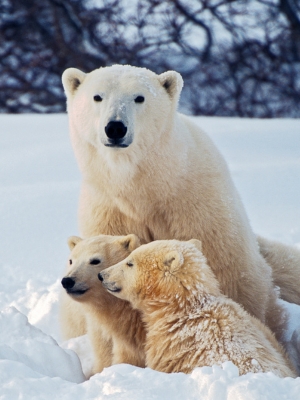In a quickly evolving and extremely strange news story, a stingray named Charlotte became pregnant despite no males sharing her tank at the Team Ecco Aquarium & Shark Lab in North Carolina. Initially deemed a “once-in-a-lifetime science mystery” by the aquarium, an early theory proposed by the aquarium postulated that one of the two young male bamboo sharks in her enclosure had impregnated her.*
The Facility Makes Light of the Situation, and Ignores Obvious Welfare Concerns
In a video posted by Team Ecco showing two aquarium employees standing in a tank with Charlotte while handling her, one staff member stated that they should have known Charlotte was pregnant when they saw her covered in shark bites, as engaging in biting is a mating behavior typical for sharks. The fact that Charlotte was bitten extensively by the sharks in her tank seemed to be of little concern for the aquarium team, however, as the staff member stated that “they didn’t think much about it” until they discovered that she was pregnant, despite her likely experiencing pain and a significantly decreased welfare state due to these attacks. Concerningly, it seems that no one has questioned why Charlotte remains in a tank where she can be, and has been, attacked by sharks to the point of serious physical injury.
When interviewed by a local news team, the executive director of Team Ecco, Brenda Ramer, added to the “mysterious” and suspenseful tone of this story and seemed to be making light of the situation when she stated that “We’re either going to have partho [referring to parthenogenesis- a natural form of asexual reproduction] babies or Jurassic Park right now!”
Getting to the Bottom of the Mystery Pregnancy
While the aquarium seemed to ride the publicity shock wave of a potential shark-stingray hybrid pregnancy, researchers specializing in these species at other aquariums set the record straight. Kady Lyons, a research scientist at the Georgia Aquarium whose graduate work focused on round stingrays, declared that it would have been impossible for Charlotte to produce viable offspring with a bamboo shark in her tank due to their anatomical and size differences. According to Christopher Lowe, a professor of marine biology and director of the Shark Lab at California State University, many species of sharks and rays can store sperm for at least one year, but because Charlotte had been on her own for too long, this explanation seems unlikely.
It turns out that Charlotte reproduced asexually (a process called parthenogenesis, in which embryos develop in the absence of fertilization); a known and studied phenomenon that the aquarium still seems baffled by and referred to as a “miracle.” Although most used by plants and invertebrate organisms, parthenogenesis has become increasingly observed in vertebrate species. While obligate parthenogenesis, where all individuals within a species reproduce asexually, is restricted to scaled reptiles like lizards and snakes, facultative parthenogenesis, or the occurrence of asexual reproduction in otherwise sexually producing species, is known to occur across major vertebrate groups including birds, bony fish, and some species of sharks and rays. According to Kevin Feldheim, a researcher and parthenogenesis specialist at Chicago’s Field Museum, Charlotte represents the first known time that parthenogenesis has been documented in her species (round stingray), and accounts for the 15th species for which parthenogenesis has been documented in an elasmobranch (a subclass of cartilaginous fish, including modern sharks, rays, skates, and sawfish).
Parthenogenesis Is Not Unheard of in Captivity
While parthenogenesis is relatively rare in rays, it has long been documented in these species in captivity for almost two decades (mostly in females in captive environments that had no exposure to males of their species during their reproductive years) and has been suggested by the zoo/aquarium industry as a tool for captive breeding programs in the name of wildlife “conservation” efforts to birth more rays in captivity belonging to species threatened with extinction in the wild.
Parthenogenesis, however, has been linked to health issues resembling those observed in individuals with low genetic diversity, like inbreeding. Warren Booth, an associate professor of entomology at Virginia Tech, recently told NPR in an interview that “Parthenogenesis has a tendency to produce offspring that are not very healthy. In all of the studies in snakes, birds, and sharks, the offspring don’t survive very long. They’re stillborn or they expire within a short amount of time.” Apparently, a DNA test on the pups after birth will determine whether they are viable offspring.
Prioritizing Exploitation Over Welfare
Unfortunately, this situation exemplifies yet another case in which the potential exploitation value of an animal has been prioritized over their health and wellbeing by a facility that uses animals for human entertainment. As parthenogenesis has been confirmed to occur more often in captivity when animals do not have access to a mate, and often results in offspring that are not viable or healthy, it seems that the constraints of captivity and those responsible for perpetuating such environments should be held responsible.
It is often tragedy that forces humans to accept the fact that we cannot expect wild animals to abandon their natural instincts (like reproducing freely) in captivity, nor can they live healthy or happy lives in forced, unnatural conditions. When will zoos and aquariums finally face the facts and acknowledge that artificially confining wild animals rarely benefits their welfare or conservation status and does not hold any educational value whatsoever; particularly when captive facilities spread scientifically impossible rumors about their animals, or suggest using potentially harmful methods of reproduction for captive breeding efforts to aid “conservation” in the wild?
Charlotte is expected to give birth to four pups any day now, though the aquarium team cannot provide a due date. The aquarium’s uncertainty over when Charlotte is due to give birth stems from the team’s inability to know exactly when she conceived.
To learn more about fish welfare in captivity, explore our 2023 report, Oceans Away From Home.
To support our efforts to stop the exploitation of fish in captivity, consider symbolically adopting a stingray!
Keep Wildlife in the Wild,
Devan
*Note: Evidence that the aquarium believed one of the bamboo sharks in Charlotte’s tank had potentially impregnated her can be found in the video on The Sun webpage. The aquarium’s spokeswoman puts this hypothesis as a possibility at the end of the video.

 Dear Reader,
Dear Reader,